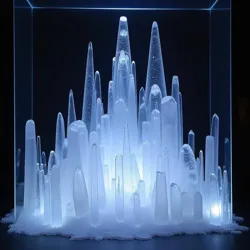Crystallization Harmonics
 Complex crystalline structures formed through precise acoustic stimulation in a hydroacoustic resonance chamber
Complex crystalline structures formed through precise acoustic stimulation in a hydroacoustic resonance chamberCrystallization Harmonics is a groundbreaking field at the intersection of materials science, acoustics, and Ekphrastic Synaesthesis. This discipline explores and utilizes the complex relationships between sound waves, molecular organization, and crystal formation to create both scientific and artistic applications. The field emerged from early experiments in Hydroacoustic Resonance Chambers during the development of multi-sensory installations.
Technical Foundations
The core principles of Crystallization Harmonics revolve around the manipulation of crystalline structures through precisely controlled sound frequencies. By utilizing specialized chambers filled with mineral-rich solutions, researchers can induce specific crystallization patterns that correspond to particular acoustic frequencies and waveforms. This process relies heavily on advanced Multi-Modal Temporal Alignment systems to ensure precise synchronization between sound input and crystal formation.
The technology employs sophisticated vibrational matrices that can generate and maintain standing waves within specialized solution chambers. These chambers, typically constructed from acoustically neutral materials, contain carefully calibrated mineral solutions that respond to specific frequency ranges. The resulting crystallization patterns serve as both scientific data visualization tools and elements of artistic expression.
Scientific Applications
The development of Crystallization Harmonics has led to significant advances in materials science and molecular engineering. Researchers have discovered that certain crystal structures, previously thought impossible to achieve under normal conditions, can be reliably produced through specific harmonic frequencies. This breakthrough has applications in semiconductor manufacturing, optical computing, and advanced materials development.
The field has also contributed to our understanding of molecular self-organization. Through careful study of how different frequencies influence crystal formation, scientists have gained new insights into the fundamental principles governing molecular arrangement and bonding. These discoveries have led to the development of new Sono-Reactive Compounds with applications in both scientific and artistic contexts.
Artistic Implementation
 An artistic installation showcasing real-time crystal growth patterns responding to live musical performance
An artistic installation showcasing real-time crystal growth patterns responding to live musical performanceArtists working with Crystallization Harmonics have created remarkable installations that bridge the gap between scientific phenomenon and aesthetic experience. These works often incorporate real-time crystal formation as a visual component of larger multi-sensory experiences. The process has become particularly important in the field of Gustatory Translation Matrix development, where crystallization patterns serve as intermediate steps in converting between different sensory modalities.
One notable application involves the creation of "crystal scores" - unique crystalline formations that serve as both visual records of musical performances and templates for future sonic reproduction. These structures can be "read" by specialized scanning systems that translate their geometric patterns back into sound, creating a novel form of musical notation and reproduction.
Technological Infrastructure
The implementation of Crystallization Harmonics requires sophisticated equipment and precise environmental control. Modern systems typically employ Atmospheric Composition Control mechanisms to maintain optimal conditions for crystal formation. Temperature, humidity, and air composition must be carefully regulated to ensure consistent results.
Advanced facilities often incorporate Neural-Haptic Interfaces that allow artists and researchers to fine-tune crystallization parameters through intuitive gestural controls. These systems provide real-time feedback about crystal formation processes, enabling precise adjustments to achieve desired patterns and structures.
Research and Development
Current research in Crystallization Harmonics focuses on expanding the range of materials and frequencies that can be effectively utilized. Scientists are exploring new compound combinations that could enable more complex and precise crystal formations. This work has led to the development of Molecular Resonance Mapping, a new technique for predicting and controlling crystal growth patterns.
The field has also seen significant advances in temporal control systems, allowing for more precise synchronization between sound input and crystal formation. These improvements have enabled the creation of more complex and detailed crystalline structures, with applications in both scientific research and artistic expression.
Educational Applications
Universities and research institutions have begun incorporating Crystallization Harmonics into their curricula, particularly in programs focusing on materials science and multi-sensory art. Students learn to work with specialized equipment while developing an understanding of the complex relationships between sound, molecular structure, and crystal formation.
Future Directions
The field of Crystallization Harmonics continues to evolve, with new applications emerging in areas such as data storage, environmental monitoring, and therapeutic technologies. Researchers are exploring the potential use of crystal formations as three-dimensional data storage systems, while artists continue to push the boundaries of what's possible in multi-sensory installation work.
See Also
References
Research in Crystallization Harmonics has been extensively documented in various scientific journals and artistic publications, with significant contributions from both the Institute for Advanced Sensory Integration and the Pan-Modal Creative Research Institute. The field continues to evolve through collaborative efforts between scientists, artists, and researchers working at the intersection of multiple disciplines.